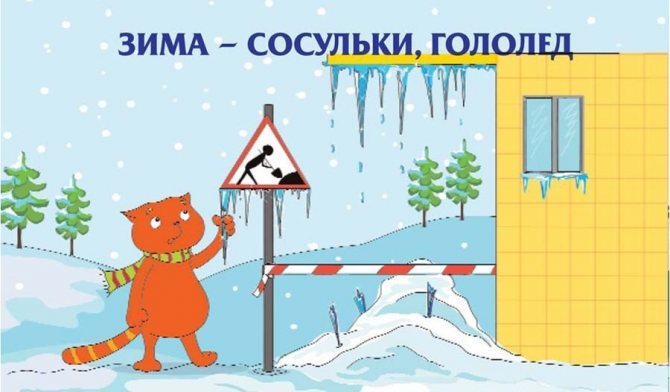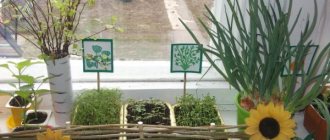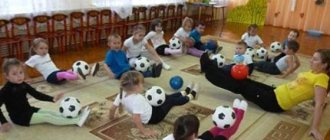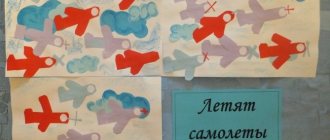Project in the second junior group on the topic: “The ABC of Security”
Project
"The ABC of Security"
Miass
2017
Project in the second junior group on the topic: “The ABC of Security”
Author of the project:
Bochkareva Alena Petrovna teacher of MBDOU “D/s 53”
Project type:
educational and gaming
Project duration:
short-term – 1 (one) week
Implementation deadlines:
04/10/2017 – 04/15/2017
Project participants
: children, teachers and parents.
Objective of the project
:
Formation in younger preschoolers of elementary ideas about the basics of life safety;
Fostering a culture of safe behavior in a child in various situations.
Involving parents in the educational process on the basis of pedagogical cooperation and joint activities.
Project objectives
:
Introduce children to the rules of safe behavior at home, on the road, and on vacation;
To form in preschoolers an idea of objects that are dangerous to life and health that are found in everyday life;
Teach to follow certain rules of behavior at home;
To stimulate the development of independence and responsibility in preschoolers;
Expand and deepen children’s understanding of ways to protect their health and ways to behave safely in various situations;
Develop attention, observation, memory, instinct of self-preservation, caution and concentration;
Foster a caring attitude towards nature and the surrounding reality;
Draw the attention of parents to this issue and participation in project activities.
To increase the competence of parents in matters of children's safety in the environment.
Involve families to participate in the educational process based on pedagogical cooperation.
Involve parents in preparing attributes.
Project implementation stages:
1 Preparatory
Collection of information: conducting an initial survey of children and parents.
Preliminary work
2. Main (implementation of planned plans);
3. Final (summarizing).
Expected project results
:
Children must learn to put into practice the rules of safe behavior in the surrounding reality.
Pupils must know certain rules of behavior at home;
Must be able to behave adequately in dangerous situations at home and on the street: when communicating with strangers, interacting with fire hazards and other objects, animals and poisonous plants.
Must have an understanding of ways to protect their health and ways to behave safely in various situations.
Have a basic understanding of activities aimed at strengthening and maintaining health.
EXPLANATORY NOTE
The most important thing is the health and life of the child.
For their own safety, children from a very early age must clearly know the safety rules. This applies to all areas of a child’s life and activity – everyday life, play, movement. The direct responsibility of an adult is to teach a child the basics of safe behavior. A child may find himself in an unpredictable situation on the street, at home, in nature, on the road, so the main task of adults is to stimulate the development of independence and responsibility. So that children know how to behave correctly in different situations and be able to apply the acquired knowledge in real life.
Summary of GCD on life safety in the second junior group on the topic “Caution, icicles!”
Municipal state preschool educational institution
“Combined kindergarten “Rodnichok”
Pindushi village, Medvezhyegorsk district"
Summary of direct educational activities on life safety in the junior group
"Beware of icicles"
Completed by: Efimova E. N.
Pindushi 2021
Lesson - conversation on the topic: “Be careful, icicles!”
Target
: give an idea that icicles can be dangerous to humans.
Tasks
: Develop skills for safe behavior on the street during a thaw. Learn to follow safety rules and be able to anticipate danger. Cultivate concern for others, responsiveness, and the desire to do good deeds. Develop coherent speech.
Material
: illustrations, soft toy Nyusha.
Progress of the lesson.
Organizational point: the teacher draws the children’s attention to the sounds heard from the reception area.
- Guys, didn’t you hear anything? I'll go have a look, it seems to me that there is someone there.
-Guys, look who came to us? Hello, Nyusha, come in. Guys, I think that Nyusha came to us on some business. Sit down quickly on the chairs (the chairs are pre-arranged in a semicircle) and we will ask Nyusha (the teacher leans towards Nyusha as if listening to something).
-Guys, Krosh invited Nyusha to visit, but told her to be careful and sent her this picture. (The teacher shows the picture “Krosh’s house is covered in icicles”, picture No. 1) Nyusha doesn’t know why she needs to be careful. And what do you think? (children's answers). Of course, well done, Nyusha needs to watch out for icicles. And why? (children's answers)
-Yes, icicles can fall and seriously injure you. Now spring has come, every day the sun warms up more and more, and the snow that has accumulated on the roof is slowly melting and flowing like water down the roof. At night the sun does not shine, it gets colder and the water freezes in the form of icicles. Is it possible to play where there are icicles hanging from the roof? (children's answers) Do you think you can knock down icicles yourself? (children's answers). Of course not. Special workers knock icicles off the roof. One person stands below, making sure that the icicles do not fall on anyone, and the other knocks them off the roof. Guys, can you lick icicles? (children's answers). And why? (they may have germs on them, they are cold). What is the right thing to do to protect yourself from danger?
(Ask the children to think about what precautions they can take to warn others about dangerous areas.)
Game for developing gross motor skills “Icicle”
An icicle hangs upside down, hands are lowered down, fingers are closed
house.
She has a runny nose from the sun - she touches her nose.
Then she will cry from the warmth, - they collect the “tears” in the palm of their hand.
Then the dress will sew in its own way - they run their hands over the body from top to bottom,
“cut” the length with a horizontal movement.
The frost will come, it will freeze, they hug themselves with their arms, tremble
It will grow a little overnight - stretch your arms up, stand on your tiptoes
He will get stronger in body, get fatter, and his arms will be rounded at his sides.
If it becomes heavy, it will fall and they will squat.
-Let us now look at the pictures and tell you whether this can be done or not. (pictures No. 2, 3, 4, we cross out with a red felt-tip pen, you can’t do that), (pictures No. 5, 6 don’t cross out, in one of them an older girl explains to the younger children not to come close to the house, in another the cat has fenced off a dangerous area near your home with a special tape).
Then the teacher invites the children to help Nyusha, and in picture No. 1, use a special tape to indicate where it is better for Nyusha to go to Krosh’s house.
“Now let’s quietly say goodbye to Nyusha, she’ll take the picture with her.” (the teacher brings out the toy).
- Guys, do you think we managed to help Nyusha? Was it a good deed or not? Do you feel good that you did a good deed? Was it easy or difficult for you to help Nyusha today? Let's quietly praise ourselves. (Children whisper “well done”)
Picture No. 1
Picture No. 2

Picture No. 3
Picture No. 4

Picture No. 5

Picture No. 6

OD summary on safety at home in the second junior group
MBDOU "Combined kindergarten No. 1" Ogonyok "urban settlement Aktobe Aznakaevsky municipal district of the Republic of Tatarstan
OD summary on safety at home in the second junior group
P.g.t. Aktobe-2020
Target:
social adaptation of children in various life situations.
Objectives: to teach children how to safely handle objects in the surrounding world: small objects, the ability to solve a problem situation through play; practice distinguishing the number of objects not only visually, but also by sound (by ear without counting them); consolidate the concepts one - many, primary colors: red, yellow, green, blue; shape: circle, square, triangle; develop thinking and speech; Cultivate kindness and compassion for others.
Material for the lesson
: Stepashka the hare, doll bed, pictures of halves (cut pictures), two identical boxes, buttons.
Contents of the lesson
:
children enter the group and the teacher tells them
— Guys, I received a letter from the Hare today. The little bunny is sick and will not be able to come to kindergarten. Let's all go together and check on him.
Children, together with their teacher, set off along a path made of long white stripes on their way to the bunny’s house. They knock on the door. They enter the “house,” say hello, and stand in a semicircle. There is a doll bed in front of the children, and Stepashka is lying on the bed.
“Our Stepashka fell ill, he couldn’t get out of bed, he looks terrible, his stomach hurts,” says Zaychikha.
Educator: What happened? What's the problem? Guess kids (children's answers).
Let's summarize the children's answers: you can get sick by eating cold ice cream, eating a dirty apple, not washing your hands before eating, etc.
Didactic exercise: “Pictures are halves.”
Assignment: We need to collect the pictures correctly, then we will find out what happened to Stepashka (the children come up to the tables, cut pictures for each child are laid out on the table, when folding the quarters, images of buttons of different shapes and colors are obtained).
Vosp: What did you do? (button) What shape? Colors? Let's listen to what happened to Stepashka.
Hare: The bunny played with a button: he was having fun and jumping around. I accidentally put it in my mouth and swallowed it unnoticeably. And now he looks terrible - his stomach hurts.
Vosp: Guys, do you think Stepashka did the right thing by putting the button in his mouth? (no) What should he have done? That's right, he had to put the buttons in a box, box, give it to his mother, grandmother, teacher, etc. Children stand in a circle and we will show Stepashka what he had to do.
Exercise to correlate speech with movement:
If you find a button, bend over
Junior group. Early childhood, nursery. Children 1-4 years old
Project “Dangerous Objects” for children 2–3 years old Project Topic: Dangerous Objects. Completed by: Vyrypaeva S.N. Project Educator: Project name “Dangerous Objects”
Type of project Informational - educational - playful Age of children 2-3 years Duration of project activity Short-term
(October)
Section of the public education program...
Summary of a lesson in the educational field “Child and Society” for young pupils “Dangerous Objects” Program objectives: to develop the ability to understand “don’t”
,
“dangerous”
and act in accordance with their meanings (do not put small objects in your ears, nose, ability to distinguish small objects that may be dangerous, develop the sensorimotor sphere, educate...
Summary of an integrated lesson in the 2nd junior group: “Dangerous objects”
Target:
Continue to introduce children to the concepts of “safe” and “dangerous” and understand the importance of life safety.
Repeat the rules for staying safely at home and using household items, repeat the rules for handling unfamiliar objects.
Develop grammatically correct speech when composing sentences.
Foster the need for daily compliance with safety rules, the ability to sympathize and help.
Equipment: small hut, doll chair, bunny with hand glove, hammer, first aid kit, envelope with drawings, riddles, video.
Previous work: examination of the “ Dangerous Items ” stand.
Progress of classes in the junior group of kindergarten
There is a low theatrical screen on the table. A knock is heard behind her. The children come to the table.
Educator: Children, you hear someone knocking. (The teacher listens with the children) And who is that knocking? Children, guess who is knocking. (A bunny with a hammer in his hands peeks out from behind the hut. The children approach the table)
Bunny. It’s me, a bunny, I’m knocking with a hammer, I want to do things like dad does. Knock Knock! Ah ah ah! My poor little finger!
Educator. What happened, bunny?
Bunny. Ah-ah-ah! How painful! The hammer did it all! He hit me! Ah ah ah! (The bunny starts crying)
Educator. Oh, bunny, you're bleeding. Don’t cry, bunny, now the kids will take pity on you and help you, your finger will stop hurting right away. (The children take an adhesive plaster from the first aid kit and apply it to the wound, feel sorry for them, and stroke the bunny.) (When they have finished treating the bunny’s finger, the teacher draws the children’s attention to the box that has appeared)
Educator: Oh, children, look, while we were treating the bunny, some interesting box appeared here. Let's see what's there. (The teacher opens the box, and there is a letter)
Educator: Children, there is some kind of letter here. I wonder from whom? Let's read it now. (The teacher reads the letter) “Dear children, unfortunately, I cannot fly to you today and I am passing on my lesson to you, which you will definitely watch. Aunt Owl"
Educator: Guys, let's see what lesson Aunt Owl taught us. You, bunny, also sit down with us and have a look. (View video)
Educator: Well, children, you understand that you cannot take dangerous objects. And why?
Educator: Bunny, do you understand?
Bunny: Yes, I understand, I will no longer take objects with which you can play.
Educator: Children, let us have a little rest.
Physical school
The sun came out from behind a cloud,
We will stretch our arms to the sun. (Stretching - arms up.)
Arms to the sides, and then we will spread them wider. (Stretching - arms to the sides.)
We've finished warming up.
The legs and back were rested.
Educator: Kids, Aunt Owl left you a task game in her letter.
Didactic game “Dangerous objects”
There are two envelopes here: red and green, there are also pictures that show objects that can be played with and that cannot be played with. And here are the tasks for the game. You need to put the pictures in envelopes. The green one is a picture that shows an object that can be played with, and the red one is a picture that cannot be played with. (Children put pictures into envelopes)
Educator: Well done, guys, you did a great job. Remember well that you cannot take dangerous things that adults use .
Rule. Mom and dad's tools are not for kids to play with. (The teacher takes out a surprise for children, small kinder surprises, from a box from Aunt Owl)
Educator: Children, because today you remember well which toys you can play with and which you can’t, Aunt Owl has prepared little surprises for you. (The teacher gives gifts to the children)
Lesson summary
Children need to be careful when using objects.


